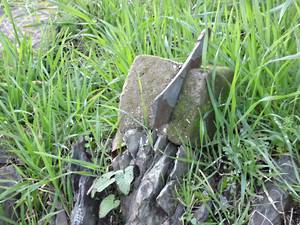Broken by time - 2016

In Situ3 Workshop, Sept 2016
After extensive research in 2000, the Dutch Nobel laureate, Paul Crutzen and his colleague Eugene Stoermer, from Michigan University, presented their findings about the geographical complexity of the earth over time. They came to emphasise the central role of humankind’s harmful cause and effect relation to the earth’s geological, planetary and atmospheric forces over the past two to three hundred years.
The Collins English Dictionary explains:
The lie of the land in 2 ways:
- The topography of the land,
- The way in which a situation is developing and people are behaving.
These are essentially the 2 main concepts we will be considering during this In Situ3 workshop.
Nature and land in this context includes the physical world and everything in it - such as plants, animals, mountains, fossils, rocks, oceans and even stars in the universe.
This also incorporates features, forces, and processes that formerly happened or existed independently of people, such as the weather patterns, the production of young animals or plants, and growth; therefore the natural forces that controlled what happened in the living world, environment, countryside, landscape, scenery
This In Situ workshop is essentially orientated towards contemplation about the manner in which elements in the environment are gradually remodelled or transformed over time - either by natural forces or by processes due to human intervention.
The contemporary relevance of this topic is that for the first time in the history of the earth the current geological age is viewed as the period during which human activity has been the dominant influence in environmental changes.
Stoermer and his colleagues proposed using the term the Anthropocene era to refer to this current stressful global transformation triggered by humans – for example; climate change, industrialisation, urbanisation, soil erosion, change in soil nitrogen levels and the extinction of species.
The experiments, research and artworks resulting from this workshop may refer to:
Slow innate eco systems, or violent and sudden organic events; be it geographical, geological, biological OR by visible and invisible human intervention. You may refer to climatic exposure, geographic consequences, the relationship between people & earth and/or ecological destruction.
The site specific class is about the relationship of art to geoscience - observing and responding to activities of rupture and fragmentation in the land(scape).
Research & References
Consider the following concepts and ideas to trigger your creativity:
- Measures of erosion and decay (Weathering, Corrosion, Decomposition, Oxidation, Destruction, Artificial deposits in soil and water, Decay and Rust).
- Sculpted by nature (Shaped, Formed, Moulded, Constructed, Impaired, Wounded, Damaged, Ruined, Mutilated, Tugged, Shifted, Repositioned, Rearranged, Transferred, Redistributed, Extracted, Twisted, Coiled, Warped, Whittled, Rotated and Wrung).
- Sketched by nature (Wet/Dry states, River, Upstream, Downstream, Pressure, Ruined, Destroyed, Collapsed, Crumbled, Loosened, Untangled, Undone, Torn, Tattered, Scuffed, Erased, Diminished, Unravelled, Unknotted, Unfinished, Unwrapped, Pry open, Nullified, Delineated, and Degenerated).
- Artefacts created by natural interventions. (Bent, Reversed, Retreated, Overturned, Meandering, Entwined, Coiled, Squashed, Re-ordered, To lose ground, Transposed, Reshuffled, Coerced and Repositioned).
- Spawned by nature (Temperatures, Oxidation, Carbon dioxide, Gravitational, Shifts, Electromagnetism, Gas, Vapour, Minerals, Floods, Droughts, Disasters, Driven, Imposed, Sensations, Migrations and Textures).
- Strata and Levels of intervention (Sediment deposits, Residue, Dregs, Territories, Obliteration, Remains, Demolition, Constraints, Imposed, Mobius loop, Shifts, Ambling, Snaking, Turning, Separations, Layers and Rays).
- Natural exposure (Wind, Water, Thunder, Fire Solar energy, Microbes, Bacteria, Synapse, Cracks, Separation, Meanders, Particles and Grains).
- Elements of Time (Tempo, Pace, Cycles, Segments, Seasons, Minutes, Hours, Moments, Tides, Generations, Periods, Phases, Intervals, Interludes, Ages, Era, Epochs, Rhythms, Measures, Dots, Statistics, Degrees, Effects, Causes, Quantities, Rations, Rates, Assess, Quantify, Calculate and Record).
(www.collinsdictionary.com/dictionary/english), (www.merriam.com/dictionary/nature) (www.dictionary.cambridge.org/dictionary/english/nature).
In Ponte da Mucela (Portugal) you will have the chance to develop your ideas through observing the cyclical, temporal character of the land and the exchange between nature and time.
We look forward to sharing your creativity.